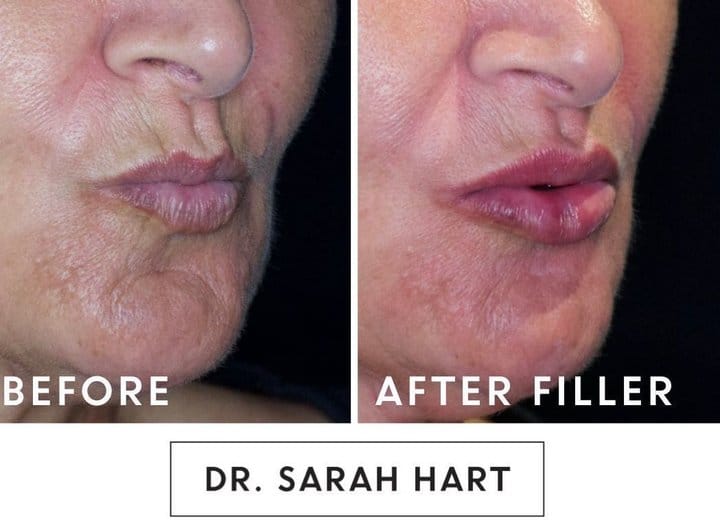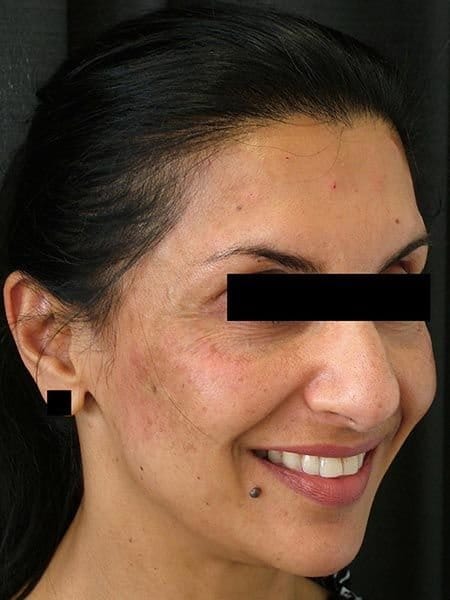Tips from an aesthetic doctor, how to look good on Zoom without treatment!
When lockdown sent us to work from home, I looked forwards to mooching around in activewear without makeup.
What bliss!
I couldn’t treat patients or teach workshops. All my international speaking engagements were cancelled. So, I wrote research papers, Zooming with colleagues in India and Taiwan.
But to my surprise, instead of concentrating on what my colleagues were saying, I was distracted by my Zoom face. “Jeeez,” I thought. “I really should have pencilled in my brows. And I didn’t realise my lip lines were so noticeable when I talked.”
I suddenly realised why actors find ageing so difficult, aside from Hollywood’s addiction to youth. Most of us see our faces in a mirror or photos, but not while we’re talking on video. And wow, the movement really highlighted my flaws.
Why does my face look so bad on Zoom?
Facial ageing changes are much more visible when we move our faces. In fact, I ask my patients to kiss, smile and frown when I’m examining them. It lets me see where age has thinned the fat under the skin, letting the muscles underneath pull more strongly on facial tissues.
Seeing these “breakpoints” tells me exactly where to put filler, stealthily supporting the face where it needs it most. Yes, movement is my friend when I’m treating faces. But when we’re trying to look our best? Not so much, because who wants all their creases shown up?
Lines show up on movement
There are other ways Zoom is extra harsh, meaning what you see on screen may look worse than real life. In fact, Zoom can be a perfect storm for exaggerating imperfections.
Can the angle make me look better or worse on Zoom
Have you ever looked downwards into your phone camera by mistake and had a heart-stopping moment of horror?
Yep, same here.
Most of the time when we look at our face, we see it straight on. Sometimes we see ourselves in an upwards tilt which is more flattering. Tilting our face up tightens our jawline and lifts our cheeks. A car rear vision mirror is great for this. It’s also why you look your best in a selfie taken with your phone held high.
But for Zoom meetings, we typically place our laptop on the desk or table and sit in a chair. Looking at the screen tilts our face downwards, making our skin hangs in rolls under our chin.
Hello… jowls.
This downwards angle is such a powerful tool for looking bad it even sparked an internet craze called “Pretty women, ugly faces”
If these young beauties can look bad from a downwards angle, what hope do the rest of us have?
Why lighting is so important on a Zoom meeting
In the days before digital anti-ageing effects, the best way to make an ageing movie star look better was clever lighting.
It’s also one of the easiest ways to fake a before/after photo. Taking the “before” photo lit from above creates big shadows under the eyes. Match it with an “after” photo lit from the front and it will magically look 10 years younger.
The lighting in our average living room typically comes straight from above. This creates shadows, highlighting eye bags and facial creases.
That’s why dermal filler can be such a good solution for Zoom-face. When I do filler, I chase shadows away, but by changing the contours of the face, rather than changing the lighting. Changing the contour changes where the light hits, restoring a fresher look.
Before – shadowing around the eyes gives a tired look
After – dermal filler can lift the contours and reduce these shadows. Individual results may vary.
Does Zoom have a filter to make my face look better?
Yes, Zoom has a filter, but it‘s less sophisticated than what Snapchat delivers, for example. It smooths out your skin texture, decreasing minor imperfections, but it doesn’t make your eyes bigger or slim your face.
Many digital-savvy types are so accustomed to using filters to look their best, they’re surprised to find they don’t like how their face looks without a filter.
If you want to try Zoom’s filter, here’s how. In the Zoom Desktop Client, click your profile picture then click Settings. Click the Video tab. In the Video Settings dialog, click Touch up my appearance. Use the slider to adjust the effect.
The filter smooths out your skin tone, but it won’t swap out activewear for a business suit, so that part is still up to you I’m afraid.
Zoom face is driving cosmetic treatments
Both my regular and new patients have mentioned “Zoom-face” when talking about their concerns recently.
The increase in the use of Zoom seems to have caused a post-lockdown boom in patients seeking facial improvements. TV3 Newshub found that not only are more people getting cosmetic injectables, they’re also looking into plastic surgery. Check out the video to see what I have to say about “Zoom-face” here.
Jowls, double chin, frown lines and lip lines are the top features people tell me they would like to correct.
It’s possible to improve these problems with simple injectable treatments like Botox, dermal filler and fat dissolving injection Belkyra.
How can I look better on my Zoom meetings?
A couple of weeks into lockdown I was invited to teach Zoom webinars. Hmmmm…speaking to hundreds of aesthetic practitioners while they scrutinised my face for ageing signs? I needed all the help I could get.
I knew I couldn’t do anything about moving my face. I had to speak! But I could use lighting and angle tricks to help.
How did I find the best set up? My 9-year-old daughter taught me how to use the Photobooth function on my Mac. It shows what the laptop camera sees so you can play with lighting and angles before Zooming.
It meant I could see that if I put my laptop on a high barstool while I sat low on a chair, the angle was great.
I could also play with lighting. The best lighting comes from directly behind the screen at about eye level. So, during the day I sat facing the window, choosing a room with no windows at the side to eliminate side-shadows. At night I used my LED ring light set at eye level behind the screen. I bought this especially for making videos. They are easy to find online and make a huge difference. My ring light adjusts from cool to warm and I choose about 2700 Kelvins for the most flattering warm tone setting.
These three simple tips – filter, angles and lighting – can really help if you’re distracted by your Zoom-face. Make sure you try them before you call me for some injectable assistance.
If you would like to find out more about how I can help please contact me here.
I’m passionate about building my skills. I’ve searched out the best teachers from around the world and attend international training events every year. Cosmetic Medicine changes so fast, keeping up-to-date is essential!
I’m also on a mission to improve patient safety and practitioner knowledge in New Zealand. I love to teach my colleagues through my training roles at NZSCM, Facecoach and Allergan.








